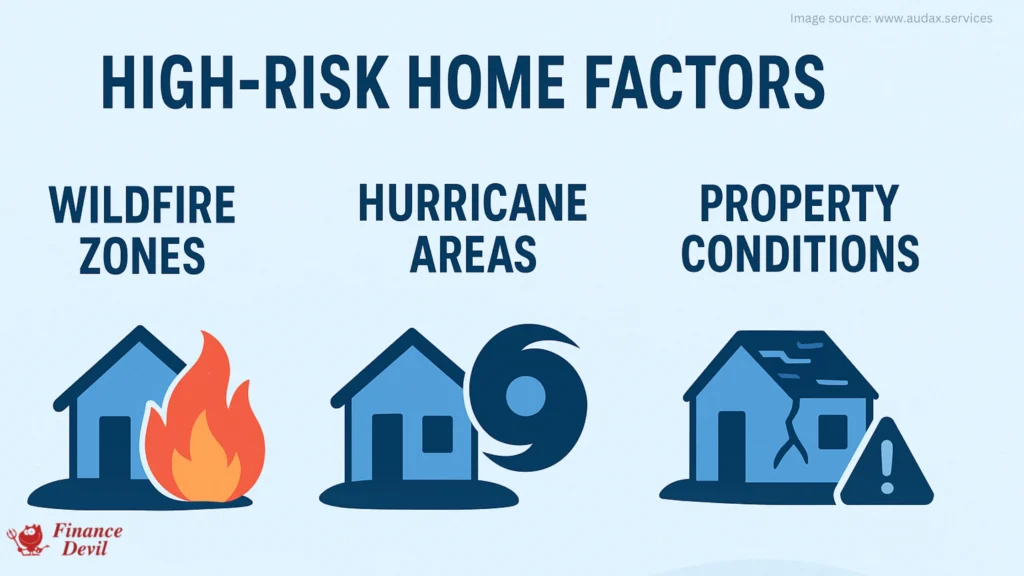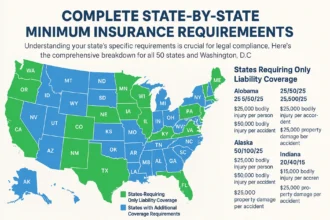
Thousands of American homeowners face insurance rejection or cancellation each month, leaving them scrambling for coverage. If you’ve been labeled “high-risk,” you’re not alone, and you’re not out of options. Here’s everything you need to know about securing high-risk homeowners’ insurance that actually protects your investment.
Why High Risk Homeowners Insurance Is So Expensive Right Now
The homeowners’ insurance market has tightened dramatically since 2023. Climate-related losses exceeded $90 billion in 2024, forcing insurers to reassess risk profiles nationwide. What was once standard coverage is now considered high-risk, particularly in:
- Wildfire-prone areas of California, Colorado, and Texas
- Hurricane zones along the Gulf Coast and Atlantic seaboard
- Flood-prone regions in the Midwest and Northeast
- High-crime urban areas with elevated theft rates
Insurance companies are pulling out of entire states or dramatically reducing new policy issuance. This creates a supply-demand imbalance that drives up costs for available coverage.
What Makes You or Your Home High Risk?
Understanding risk factors helps you address them strategically. High risk homeowners insurance becomes necessary when insurers identify elevated claim probability based on:
Property-Related Risk Factors
Location Hazards:
- Wildfire zones (CAL FIRE Severity Zones in California)
- Hurricane-prone coastal areas
- Earthquake fault lines
- High-crime neighborhoods with elevated theft rates
- Areas with frequent severe weather events
Structural Issues:
- Homes over 40 years old without recent updates
- Roofs older than 20 years or showing wear
- Outdated electrical systems (knob-and-tube wiring)
- Plumbing issues or water damage history
- Swimming pools without proper safety features
- Trampolines or other liability-prone equipment
Property Characteristics:
- Vacant homes or seasonal properties
- Homes with previous unrepaired damage
- Properties with oil tanks or environmental hazards
- Historic homes with unique construction challenges
Personal Risk Factors
Claims History:
- Multiple claims within 5-7 years
- Water damage or mold-related claims
- Liability claims from injuries on property
Credit and Financial History:
- Credit scores below 650 (in states where allowed)
- Bankruptcy or foreclosure history
- Inconsistent premium payment history
Lifestyle Factors:
- Owning certain dog breeds (pit bulls, rottweilers, German shepherds)
- Operating a home-based business
- Short-term rental hosting (Airbnb, VRBO)
- Criminal history involving property crimes
Best High Risk Homeowners Insurance Companies for 2025
Not all insurers flee from challenging properties. Several companies specialize in or accept high-risk coverage:
National High-Risk Insurance Providers
- MoneyGeek Score: 90/100
- Strengths: Third-highest customer satisfaction in J.D. Power 2024 study
- Coverage: Water backup, identity fraud protection, business property coverage
- Best for: Homes in flood/earthquake zones with comprehensive coverage needs
- MoneyGeek Score: 88/100
- Strengths: Vacant home coverage, equipment breakdown protection
- Coverage: Hidden water damage, sump pump protection, credit theft monitoring
- Best for: Vacant properties and homes with water damage concerns
- MoneyGeek Score: 67/100
- Strengths: Extensive add-on options, nationwide availability
- Coverage: Electronic data recovery, green improvement reimbursement, identity theft restoration
- Best for: Properties needing extensive customization options
- Strengths: Nationwide availability, hurricane-specific coverage
- Coverage: Water backup protection, scheduled items, wind/hail damage
- Best for: Hurricane-prone coastal properties
Regional Specialists by State
Florida High-Risk Insurers:
- Universal Direct: Automated online quotes with local agent support
- Tower Hill: High-value home specialists with dedicated agents
- Citizens Property Insurance Corporation: State-run insurer of last resort
Texas High-Risk Options:
- Texas Farm Bureau: State-specific coverage with rural expertise
- Texas Windstorm Insurance Association (TWIA): Coastal wind/hail coverage
- Chubb Lloyds Insurance Company of Texas: Premium coverage with HomeScan technology
California High-Risk Providers:
- Grange Insurance: Customizable coverage with recreational vehicle protection
- American Modern: Named peril policies with Enhanced Coverage endorsements
- Capital Insurance Group (CIG): Comprehensive add-ons for unique risks
How to Get High Risk Homeowners Insurance: Step-by-Step Process
Step 1: Assess Your Risk Profile
Document exactly why you need high-risk coverage:
- Obtain your CLUE report (Comprehensive Loss Underwriting Exchange)
- Review credit reports for accuracy
- List all property risk factors
- Gather documentation of recent home improvements
Step 2: Address Fixable Issues First
Some risk factors can be eliminated or reduced:
- Replace aging roofs (can reduce premiums by 15-30%)
- Update electrical systems to modern standards
- Install security systems (5-20% discounts available)
- Remove or fence swimming pools/trampolines
- Complete deferred maintenance projects
Step 3: Shop Strategic Carriers
Don’t waste time with insurers unlikely to accept your risk:
- Contact regional specialists first
- Work with independent agents familiar with high-risk markets
- Consider surplus lines insurers for unique properties
- Get quotes from at least 5-7 carriers
Step 4: Consider FAIR Plans as Last Resort
Fair Access to Insurance Requirements (FAIR) Plans exist in 32 states plus Washington D.C. These state-run programs provide basic coverage when private markets fail.
FAIR Plan Coverage Limitations:
- Fire, windstorm, vandalism, and riot only
- No theft, liability, or personal property coverage in many states
- Higher deductibles and premiums than private insurance
- Limited dwelling coverage amounts
States with FAIR Plans: Alabama, California, Connecticut, Delaware, Florida, Georgia, Hawaii, Illinois, Indiana, Iowa, Kansas, Kentucky, Louisiana, Maryland, Massachusetts, Michigan, Minnesota, Mississippi, Missouri, New Jersey, New Mexico, New York, North Carolina, Ohio, Oregon, Pennsylvania, Rhode Island, South Carolina, Texas, Virginia, Washington, West Virginia, Wisconsin
High Risk Homeowners Insurance Costs and Money-Saving Strategies
High-risk premiums typically cost 25-100% more than standard policies. Average costs by risk factor:
| Risk Factor | Premium Increase |
| Wildfire zone | 50-150% |
| Hurricane area | 40-120% |
| Poor credit (where allowed) | 25-75% |
| Claims history | 30-100% |
| Older home (50+ years) | 20-60% |
| Swimming pool | 10-25% |
Proven Cost-Reduction Strategies
1. Raise Deductibles Strategically
- Increase deductibles from $1,000 to $2,500: Save 10-15%
- Choose percentage deductibles in wind/hail zones: Save 15-25%
- Maintain separate wind/hail deductibles where required
2. Bundle Insurance Policies
- Home + auto bundling: Save 5-25%
- Add umbrella liability: Additional 5-10% discount
- Consider life insurance bundling for additional savings
3. Maximize Available Discounts
- Security system discounts: 5-20%
- Impact-resistant roofing: 10-30% in wind zones
- Gated community discounts: 2-15%
- Senior citizen discounts: 5-15%
- New home discounts: 5-15%
4. Improve Your Risk Profile
- Install smart home monitoring systems
- Complete defensive space clearing in wildfire zones
- Upgrade to hurricane shutters in coastal areas
- Maintain claims-free history for 3-5 years
READ ALSO: How to Find the Cheapest Car Insurance in Mississippi
High Risk Homeowners Insurance Alternatives
Surplus Lines Insurance
Non-admitted insurers writing coverage for risks rejected by standard markets:
- Higher coverage limits available
- More flexible underwriting
- No state guarantee fund protection
- Typically 20-50% more expensive than standard coverage
Self-Insurance Strategies
For high-net-worth individuals with substantial assets:
- Increase liquid savings equal to potential losses
- Purchase umbrella liability separately
- Consider captive insurance arrangements
- Maintain minimum required coverage only
Risk Mitigation Investments
Sometimes prevention costs less than insurance:
- Wildfire defensible space: $5,000-15,000 vs. 50% premium increases
- Hurricane shutters: $3,000-8,000 vs. 30% premium increases
- Electrical upgrades: $8,000-15,000 vs. potential coverage denial
Red Flags to Avoid When Shopping for High-Risk Homeowners Insurance
Predatory Practices
- Unusually low quotes that increase dramatically at renewal
- Pressure to sign immediately without review time
- Agents requesting upfront payments before coverage confirmation
- Companies with poor financial strength ratings (below B+)
Coverage Gaps
- Policies excluding common perils in your area
- Insufficient dwelling coverage limits for rebuilding costs
- No inflation guard or extended replacement cost coverage
- Liability limits below $300,000 minimum
Administrative Issues
- Companies with excessive complaint ratios
- Poor claims handling reputations
- Limited local agent networks for claim support
- Unclear policy language regarding coverage triggers
Getting Back to Standard Insurance Markets
High-risk status isn’t permanent. Homeowners can typically return to standard markets by:
Maintaining Clean Records:
- 3-5 years without claims
- Consistent premium payments
- No coverage lapses or cancellations
Property Improvements:
- Roof replacement within 10 years
- Electrical and plumbing updates
- Enhanced security systems
- Disaster-resistant upgrades
Credit Score Improvement:
- Maintain scores above 650 consistently
- Pay all bills on time
- Reduce debt-to-income ratios
- Monitor credit reports for errors
Conclusion: Secure Your High Risk Homeowners Insurance Today
High-risk homeowners’ insurance requires patience, strategy, and persistence, but coverage is available. Market conditions change rapidly, and companies adjust their risk appetite regularly. What matters most is acting quickly when you find acceptable coverage, as availability can disappear without notice.
Don’t let a high-risk label leave you unprotected. Insurance rates fluctuate daily, and the coverage available today may not exist tomorrow. Start your search immediately, compare multiple options, and secure protection for your most valuable asset.
Frequently Asked Questions
Can I be denied homeowners insurance completely?
Yes, insurance companies can legally deny coverage based on risk assessment. However, denial by one company doesn’t mean all companies will reject you. FAIR plans exist as coverage of last resort in most states.
How long does high-risk status typically last?
Most homeowners can return to standard markets after 3-5 years of claims-free history, assuming underlying risk factors are addressed. Property-related risks (location, age) may require permanent high-risk coverage.
What’s the difference between high-risk and surplus lines insurance?
High-risk insurance comes from standard admitted insurers who accept challenging risks. Surplus lines insurance comes from non-admitted insurers specializing in unusual or very high-risk properties. Surplus lines typically costs more but offers broader coverage.
Do FAIR plans cover personal property?
Coverage varies by state. Some FAIR plans include basic personal property coverage, while others cover dwellings only. You may need separate policies for contents, liability, and additional living expenses.
Can I get high-risk coverage if I have bad credit?
Yes, though it affects pricing in most states. Some high-risk insurers specialize in poor credit customers. Focus on companies that consider your overall risk profile rather than credit score alone.
How do I know if my area is considered high-risk?
Check with your state insurance department for risk maps. Wildfire risk maps from CAL FIRE, FEMA flood maps, and hurricane zone designations indicate high-risk areas. Local agents familiar with regional markets provide valuable insight.
What happens if my current insurer drops me mid-policy?
Insurers must provide 30-60 days notice (varies by state) before non-renewal. Use this time to secure replacement coverage. Never let coverage lapse, as gaps make future coverage more difficult and expensive to obtain.
Should I work with an independent agent for high-risk coverage?
Yes, independent agents represent multiple insurers and understand which companies accept specific risk types. They can efficiently navigate the high-risk market and find coverage you might miss shopping directly.
Can home improvements remove high-risk status?
Certain improvements can help: new roofs, electrical upgrades, security systems, and disaster-resistant features. However, location-based risks (wildfire zones, hurricane areas) typically require permanent high-risk coverage regardless of improvements.
Is high-risk homeowners insurance tax deductible?
Generally no, unless you use part of your home for business purposes. Consult a tax professional for specific situations involving home offices, rental properties, or business use of your residence.
In another related article, Toyota Auto Insurance: Complete 2025 Guide to Save Money on Coverage (Even If You Don’t Own a Toyota)





